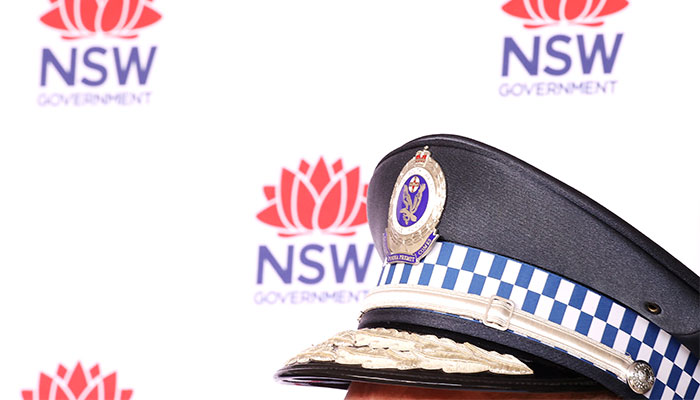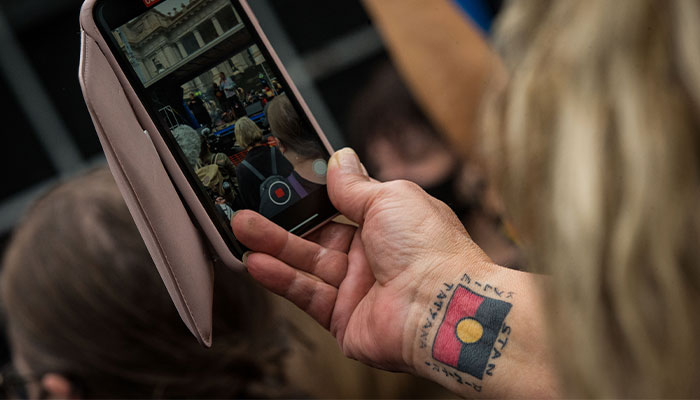Aboriginal and Torres Strait Islander people should be aware that this story contains images and names of deceased persons.
The late Indigenous Australian actor and musician Stephen Albert played many roles, but one of his most significant was his stint aged just 27 as the first Chair of the National Aboriginal Education Committee (NAEC) from 1977 to 1981.
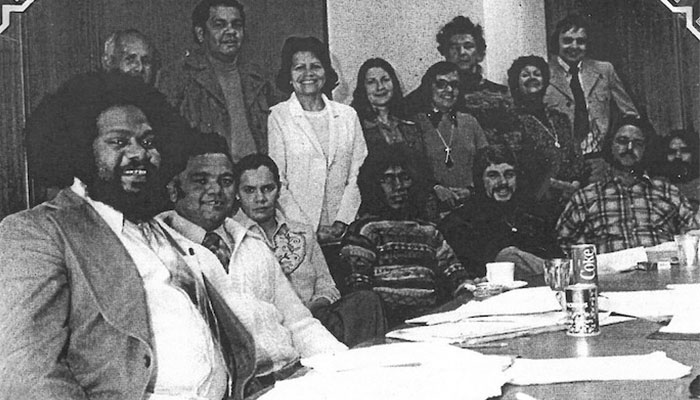
Strong leaders: The all-Indigenous members of the National Aboriginal Education Committee influenced education participation, retention and success.
“Two hundred years of nothing – then 40 years of something really good,” was Albert’s succinct appraisal of the NAEC’s flow-on effects on the education of Aboriginal and Torres Strait Islander people from its 1977 inception and beyond its conclusion in 1989.
“The members of the NAEC were a remarkable group of people,” says Dr Leanne Holt, who is Pro Vice-Chancellor (Indigenous Strategy) at Macquarie University, and whose new book, Talking Strong, revisits the role of the NAEC in altering the face of Aboriginal education.
Stephen Albert – a diesel mechanic who co-founded the band Broome Beats – had also helped set up the National Aboriginal Torres Strait Islander Student Union while he was a humanities student at Adelaide’s Institute of Technology, and simultaneously lecturing at the Aboriginal Community College.
NAEC realised that increasing the number of Aboriginal teachers in schools would increase participation of Aboriginal students, and raise Aboriginal knowledge in schools
Other NAEC members included May O’Brien, the first Aboriginal teacher in Western Australia, who grew up on a mission; and Colin Bourke, the first Aboriginal school Principal in Victoria, and the first Aboriginal Deputy Vice Chancellor.
Holt’s book includes selections from her many interviews with key members of the all-Aboriginal Committee, which advocated for desperately needed education reform between 1977 and 1989.
State of play
“One of the key aims for the NAEC was to get 1000 Aboriginal teachers into schools by 1990,” says Holt.
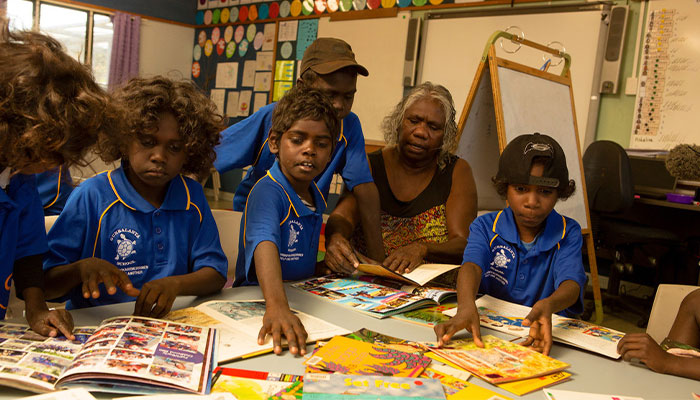
Education for all: A classroom in the Northern Territory today ... up to 1975, Aboriginal students in some states could be excluded from classrooms at the request of non-Aboriginal parents. Photo credit: NT Government
“The committee realised that increasing the number of Aboriginal teachers in schools would increase participation of Aboriginal students, and also raise Aboriginal knowledge in schools, so that all students and staff could benefit from greater awareness of culture,” she says.
Teachers would also serve as role models to other young Aboriginal and Torres Strait Islander people and help to build the capacity and the qualifications of Aboriginal and Torres Strait Islander people, she adds.
Holt says that even up to 1975 some Australian states had ‘exclusion on demand’ policies that allowed Aboriginal students to be excluded from classrooms at the request of non-Aboriginal parents, which contributed to low numbers of Aboriginal and Torres Strait Islander children completing high school.
A 1973 government review of Australia’s schools found that schools with large enrolments of Aboriginal and Torres Strait Islander children had some of the worst conditions.
NAEC initiatives included the introduction of Aboriginal and Torres Strait Islander centres in universities set up to provide a safe and supportive space for Aboriginal education students.
While the scheme led to more than the targeted 1000 Aboriginal and Torres Strait Islander people completing university-level teacher training by 1990, not all teaching graduates ended up in classrooms.
Despite this, Holt says that the NAEC’s initiatives raised graduate Aboriginal and Torres Strait Islander teacher numbers significantly, and these have continued to rise.
The NAEC initiative also greatly increased the participation of Aboriginal and Torres Strait Islander people entering tertiary education and being employed in the Australian Public Service (APS), reducing the number of Aboriginal and Torres Strait Islander teaching graduates who took up classroom-based roles.
- The power of quotas and why Australia needs them
- Hero volunteers of the AIDS crisis tell their stories at last
By 1996, the APS had 3390 Aboriginal and Torres Strait Islander employees, making up 2.63 per cent of the workforce.
While Aboriginal and Torres Strait Islander teacher numbers have continued to rise, there remains a big disparity in the proportion of Aboriginal and Torres Strait Islander people working as teachers relative to the percentage of Aboriginal and Torres Strait Islander students in Australian schools and preschools.
While Aboriginal and Torres Strait Islander students accounted for around six per cent of all Australian preschool and school students, estimates from the most recent Census in 2016 show that Aboriginal and Torres Strait Islander people made up 2.36 per cent of all preschool teachers, 2.13 per cent of all primary school teachers, 1.75 per cent of all secondary teachers and 1.32 per cent of all special school teachers.
Historic consultation
The NAEC was set up after a 1973 government review of Australia’s schools found that schools with large enrolments of Aboriginal and Torres Strait Islander children had some of the worst conditions in the nation.
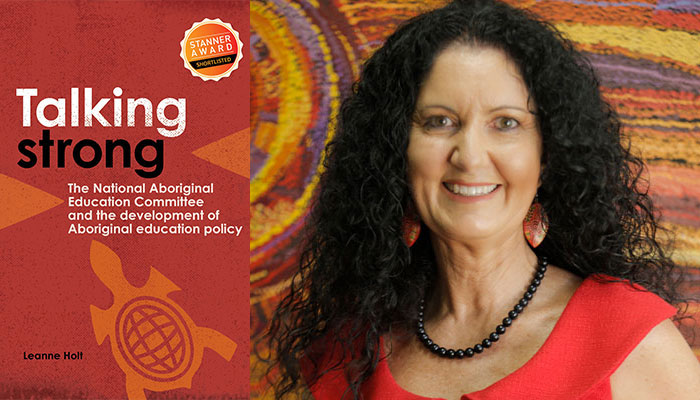
Ongoing impact: Dr Leanne Holt, author of Talking Strong, says Aboriginal and Torres Strait Islander teacher numbers have continued to rise as a result of NAEC initiatives.
The review recommended an education advisory committee be established, with full membership comprising Aboriginal and Torres Strait Islander people.
“Margaret Valadian – who was the first Aboriginal woman to graduate from university in Australia – was appointed to head the new national Aboriginal Consultative Group on education, and this was the first time that Indigenous voices had a voice on education, at a national level,” says Holt.
Valadian’s group consulted with Aboriginal and Torres Strait Islander peoples and communities across Australia, delivering a report covering everything from early childhood through to primary and secondary schools, and higher education from TAFE to university.
The group recommended the establishment of the NAEC which then gave advice about Indigenous education to the federal Minister for Education for the next 15 years.
- One-third of backyard soil unsafe to grow vegies
- Underwater drama as bossy stingray rules like a despot
“Much of this work led to the development of the National Aboriginal Education Policy which continues today,” says Holt.
Holt says that the policy has played an important role in increasing school retention and university enrolments.
“Aboriginal and Torres Strait Islander centres within universities have carried much of the load in advancing Aboriginal and Torres Strait Islander higher education across student success, increasing Aboriginal and Torres Strait Islander academic workforce, Indigenous learning, teaching and research,” she says.
“We’re now calling out for universities to take a whole-university responsibility that moves from Indigenous higher education being seen as a liability to instead a value add proposition, contributing to universities’ unique knowledges, experiences and perspectives.”
Dr Leanne Holt is Pro Vice-Chancellor (Indigenous Strategy) at Macquarie University

